
Nintendo's Family Computer, or Famicom, turns 30 today!
We're right on the cusp of another generation of game consoles, and whether you're an Xbox One fanperson or a PlayStation 4 zealot you probably know what's coming if you've been through a few of these cycles. The systems will launch in time for the holidays, it will have one or two decent launch titles, there will be perhaps a year or two when the new console and the old console coexist on store shelves, and then the "next generation" becomes the current generation—until we do it all again a few years from now. For gamers born in or after the 1980s, this cycle has remained familiar even as old console makers have bowed out (Sega, Atari) and new ones have taken their place (Sony, Microsoft).
It wasn't always this way.
The system that began this cycle, resuscitating the American video game industry and setting up the third-party game publisher system as we know it, was the original Nintendo Entertainment System (NES), launched in Japan on July 15, 1983 as the Family Computer (or Famicom). Today, in celebration of the original Famicom's 30th birthday, we'll be taking a look back at what the console accomplished, how it worked, and how people are (through means both legal and illegal) keeping its games alive today.
From Japanese beginnings to American triumphs
The Famicom wasn't Nintendo's first home console—that honor goes to the Japan-only "Color TV Game" consoles, which were inexpensive units designed to play a few different variations of a single, built-in game. It was, however, Nintendo's first console to use interchangeable game cartridges.
The original Japanese Famicom looked like some sort of hovercar with controllers stuck to it. The top-loading system used a 60-pin connector to accept its 3-inch high, 5.3-inch wide cartridges and originally had two hardwired controllers that could be stored in cradles on the side of the device (unlike the NES' removable controllers, these were permanently wired to the Famicom).
The second controller had an integrated microphone in place of its start and select buttons. A 15-pin port meant for hardware add-ons was integrated into the front of the system—we'll talk more about the accessories that used this port in a bit. After an initial hardware recall related to a faulty circuit on the motherboard, the console became quite successful in Japan based on the strength of arcade ports like Donkey Kong Jr. and original titles like Super Mario Bros.
 An early prototype of what would become the North American version of the Famicom. The Nintendo Advanced Video System communicated with its peripherals wirelessly through infrared.
An early prototype of what would become the North American version of the Famicom. The Nintendo Advanced Video System communicated with its peripherals wirelessly through infrared.
The North American version of the console was beset by several false starts, to say nothing of unfavorable marketing conditions. A distribution agreement with then-giant Atari fell through at the last minute after Atari executives saw a version of Nintendo's Donkey Kong running on Coleco's Adam computer at the 1983 Consumer Electronics Show (CES). By the time Atari was ready to negotiate again, the 1983 video game crash had crippled the American market, killing what would have been the "Nintendo Enhanced Video System" before it had a chance to live.
Nintendo decided to go its own way. By the time 1985's CES rolled around, the company was ready to show a prototype of what had become the Nintendo Advanced Video System (AVS). This system was impressive in its ambition and came with accessories including controllers, a light gun, and a cassette drive that were all meant to interface with the console wirelessly, via infrared. The still-terrible market for video games made such a complex (and, likely, expensive) system a tough sell, though, and after a lukewarm reception, Nintendo went back to the drawing board to work on what would become the Nintendo Entertainment System we still know and love today.
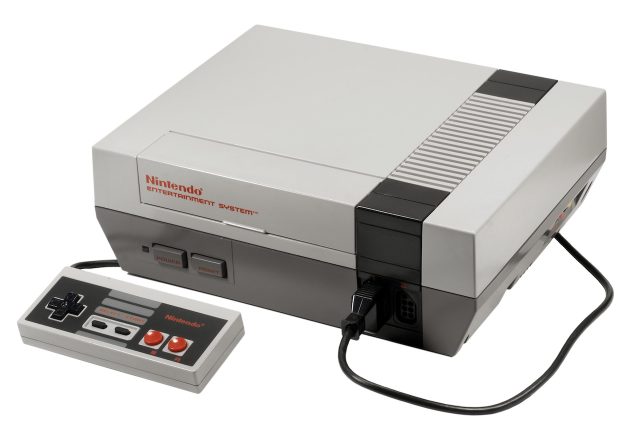 By late 1985, Nintendo had settled on the console design that most American readers will be the most familiar with.
By late 1985, Nintendo had settled on the console design that most American readers will be the most familiar with.
What Nintendo went to market with in October 1985 wasn't just a console redesigned for a new territory, but a comprehensive re-branding strategy meant to convince Westerners that the NES wasn't like those old video game consoles that had burned them a few years before. This new Famicom was billed as an "entertainment system" that required you to insert "game paks" into a "control deck," not some pedestrian video game console that took cartridges. The console's hardware followed suit—it was still marketed to kids, but the grey boxy Nintendo Entertainment System looked much more mature than the bright, toy-like Famicom. At the same time, accessories like R.O.B. the robot assured parents that this wasn't just for "video games"—still dirty words to many consumers.
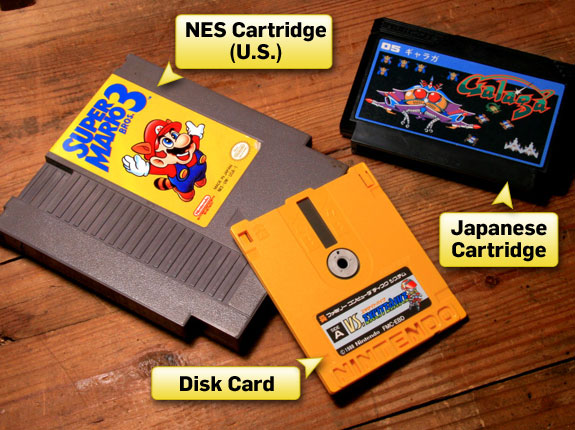
Note the drastic differences between American and Japanese game cartridges. The disk card pictured here was intended for use with the Japan-only Famicom Disk System.
Each of the titles in the relatively strong 18-game launch lineup (remember, at this point the system had been humming along for more than two years in Japan) also featured box art that accurately depicted the graphics of the game inside, unlike the disappointing exaggerations of the Atari 2600 version of Pac-Man or the infamous E.T.
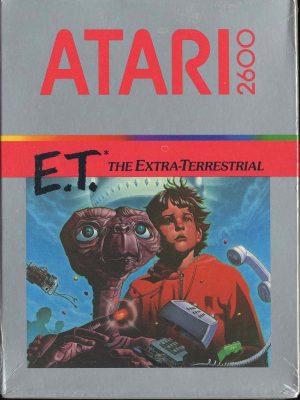 The E.T. box for the Atari 2600.
The E.T. box for the Atari 2600.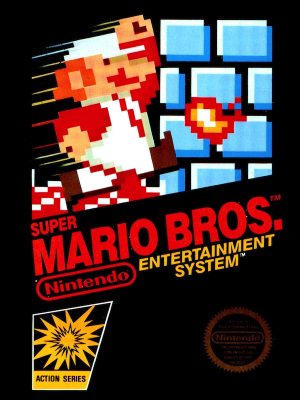 The Super Mario Bros. box for the NES.
The Super Mario Bros. box for the NES.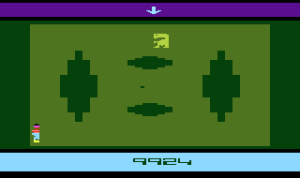 E.T. running on the Atari 2600.
E.T. running on the Atari 2600.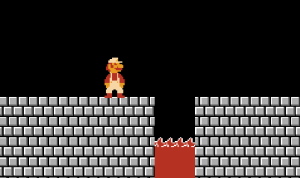 Super Mario Bros. running on the NES.
Super Mario Bros. running on the NES.
The final building block in the NES rebuild of the North American game industry was the way Nintendo handled third-party developers. In the Atari era, everyone from Sears to Quaker Oats tried to grab a slice of the gaming pie. The fact that basically anyone could design and sell hastily-coded Atari 2600 games with no interference from or cooperation with Atari led to a game market flooded with shovelware and to clearance bins filled with unsellable dreck. This in turn led to gun-shy retailers and consumers.
Nintendo clamped down on this hard. Third parties had to be licensed to develop games for Nintendo's system, and Nintendo's licensing terms both prohibited developers from releasing games for other consoles and confined them to releasing just two games a year. Other restrictions, mostly aimed at weeding out religious and other "inappropriate" content, were also imposed—memorably, these restrictions resulted in the Super Nintendo port of Mortal Kombat where all the kombatantscombatants ooze "sweat" instead of blood. Developers agreed to the restrictions in order to get access to a base of NES fans rabid for new software. (Many of Nintendo's restrictions weren't relaxed until the early '90s when it was losing developers to its first credible competition, the Sega Genesis.)
Licensed games received both a printed Seal of Quality on their boxes and access to the proprietary 10NES lockout hardware, a chip on the cartridge's circuit board that checked in with a corresponding chip on the console's. While not foolproof, in the early days of the NES the 10NES hardware helped to combat the flood of low-quality software that had killed off Atari and its ilk.
Not all developers were happy with these terms, but fighting Nintendo was an uphill battle. The most significant challenge to the 10NES system came from Tengen, a subsidiary of Atari Games. Rather than try to circumvent 10NES, Tengen used Nintendo's copyright documents to reverse-engineer the chip and create its own compatible version, codenamed "Rabbit." Nintendo sued for patent infringement and, at least in part because Tengen didn't use a clean room design in Rabbit, the judge ruled in Nintendo's favor.
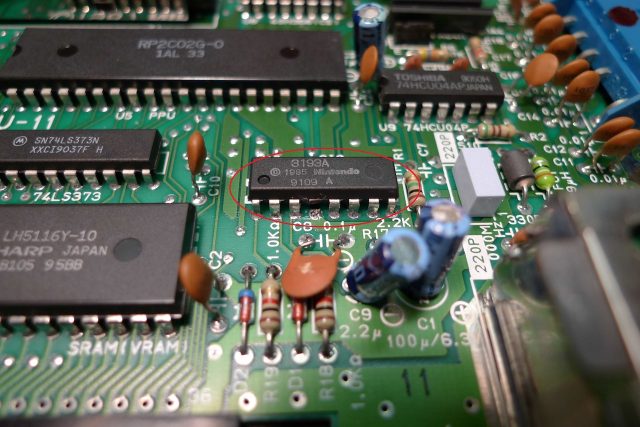
The 10NES chip would prevent the system from booting if its security check failed. It was important in the early days, but NESes with dirty or worn connectors are prone to failing its check—this led to the dreaded grey blinking screen that I've probably spent hours of my life looking at. The redesigned top-loading NES shipped without a 10NES chip, and some people who repair older NES consoles recommend snapping off the fourth pin of the chip to disable the check entirely, as shown here.
And the rest is really history. The NES was the undisputed leader in the US for several years and wasn't seriously challenged until Sega's Genesis kicked off the 16-bit era. In some territories like Europe and South America, the 8-bit Sega Master System had gained a stronger foothold, but it was a relative rarity in the US. A new top-loading version of the NES and the Famicom with a redesigned controller was launched in both America and Japan in 1993 after the introduction of the Super Nintendo, but by then the stream of high-profile software had slowed to a trickle. The system was produced until 1995 in the US but lived to see its 20th birthday in Japan before being discontinued in 2003.
Diving deeper: Inside the Famicom
The Famicom's internal hardware was designed to be both relatively powerful and relatively inexpensive for the time. The result was something much more capable than the Atari 2600 and its contemporaries, even if it seems positively prehistoric by today's standards. The system had two main processors: the CPU was a variant of the 8-bit MOS Technology 6502. Other members of that processor family made it into everything from the Atari 2600 to the Apple IIe, so in this case the Famicom was in good company. The processor was clocked at about 1.79MHz, and it had access to a whopping 2KB of RAM.
Graphics were handled by a custom chip called the Picture Processing Unit (PPU), a 5.37MHz chip which itself had access to another 2KB of RAM. A further 256 bytes of memory, called Object Attribute Memory (OAM), were integrated directly into the PPU dies, storing information needed to display sprites. There were 28 more bytes of RAM to hold information pertaining to the system's color palette. The PPU can output pictures at a resolution of 256×240. However, on most NTSC television sets the top eight pixels and the bottom eight pixels were usually hidden by overscan, giving many games an effective resolution of 256×224.
The OAM and palette memory on the NES severely restrict how many objects can be onscreen at a time and how many of the system's 54 colors can be displayed at a time. The OAM can store data for a total of 64 sprites, or four bytes for each sprite, set against a tiled background. The palette memory can display up to 25 colors on screen at a time: one background color, four sets of three tile colors, and four sets of three sprite colors.

Standard sprites can be either eight pixels wide by eight pixels high or eight pixels wide by 16 pixels high. Let's take Mario (above) as an example. From his earliest days as Jumpman, the light-skinned dark-haired Mario was depicted on the side of arcade cabinets and in instruction manuals wearing worn red overalls with a blue shirt, along with a black mustache and bright yellow buttons. The Famicom's technical limitations render his hair and his shirt the same color. His skin, the buttons on his overalls, and the spot on his hat are also the same color by hardware necessity.

The NES color palette contained only 54 usable colors, but the real limiting factor was that only three can really be used on a sprite or tile at a time.
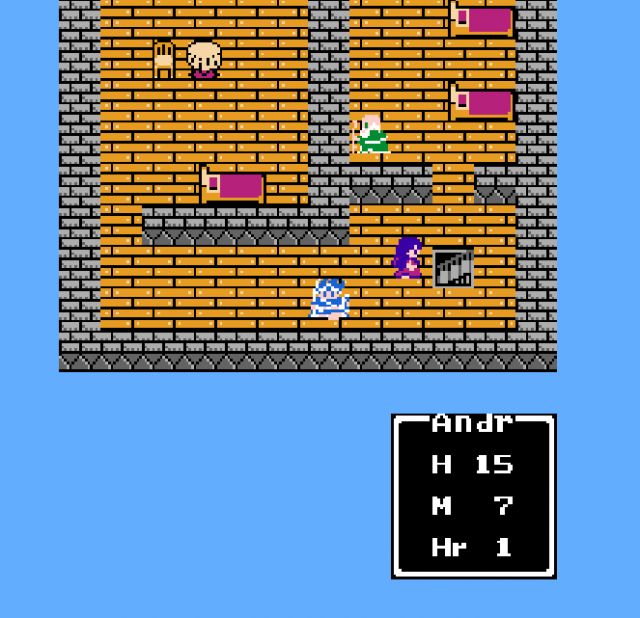
Three sets of three tile colors and three sets of three sprite colors can be used onscreen at once. Each character in this Dragon Warrior III screenshot uses a different set of three colors.
Of course, these limits can be circumvented. Smaller sprites can be placed side-by-side to create larger "meta-sprites," which is how most sprites in NES games are actually put together. The mushroom sprite from Super Mario Bros., for example, is four eight by eight sprites put together, while Super (a.k.a "big") Mario himself is made of four eight by 16 sprites. Individual sprites can also be layered creatively to overcome the color limitations—this is how Mega Man's helmet is two shades of blue and his eyes are a different color than the rest of his face. None of these arrangements can be infinite, though—in addition to the 64 sprite limit, only eight sprites can be displayed on the same horizontal line of the screen at once before annoying and distracting sprite flickering sets in (see games like Super Dodge Ball for a prime example of this limitation).
Sprite flickering is distracting, but in its way it's a workable temporary fix for displaying more than eight sprites on a line—by flickering the sprites rather than just making one vanish entirely, the player can still at least see what's going on.
Finally, there's the Famicom's audio hardware, a setup that transcended its limitations and gave us some of gaming's most memorable tunes, launching an entire musical subgenre in the process. The NES has five sound channels, each of which has its own distinct characteristics.
First up are the two identical pulse wave channels, which are generally used for melodies. The are capable of different "voices" depending on their pulse width, and they can each be set to one of sixteen volume levels. Pulse widths of 12.5, 25, 50, and 75 percent are available, with the 25 and 75 percent widths making identical sounds.
The triangle wave channel has only one voice and only one volume level, and it usually provides a bassline and augments the percussion. The noise channel can output a static-like sound in two modes with 16 different pitches per mode, and developers normally used it to create percussion tracks.
Finally, the sample channel is more rarely used because the samples take up a (comparatively) large amount of storage space. Still, these samples can be used to create slightly more complex sounds than the other channels are capable of. The bongo sound effects in Super Mario Bros. 3 and the cheering of the crowd in Mike Tyson's Punch Out!! are both prominent examples.
For a more detailed primer, this excellent video by YouTube user explod2A03 does a concise job of describing the basics about each channel (with examples!). He also has several other good explainer videos that show off how creative composers can work around the system's limitations to produce more complex sounds.
Extending the hardware
What we've talked about so far covers the capabilities that the Famicom and the NES had out of the box. In the seven years between the launch of the Famicom and its replacement by the Super Famicom in late 1990, the console received a number of performance boosts from a long series of hardware add-ons.
The most common way to extend the console's performance was through the use of Memory Management Controllers (MMCs, also called "mappers" in the emulation community), small chips that were embedded in the game cartridges themselves. Nintendo would continue to use similar on-cartridge chips to improve system performance well into the Super Nintendo era, even giving some of them their own branding—the SuperFX chip used in Star Fox and other games is probably the most prominent of these—but the practice started on the Famicom.
The most common chips used in NES games were MMC1 and MMC3. The former implemented support for game saves and for scrolling up and down as well as side-to-side (it was used in The Legend of Zelda among other titles). MMC3 allowed diagonal scrolling, and it also made it possible to keep a section of the screen static while scrolling another section normally. Both of these abilities are shown off to great effect in Super Mario Bros. 3.
These weren't the only add-on chips of course. Nintendo's MMC5 (used most prominently inCastlevania III) was its most powerful, adding a kilobyte of extra RAM, two extra sound channels, vertical split screen scrolling, and some additions to help overcome the NES' color palette limitations. Third-parties like Konami, Namco, and Sunsoft also made their own add-on chips, though these were mostly restricted to Japan. This self-described "Bigass NES Mapper List" is a reasonably comprehensive record of which games used which chips.
Accessories that used the Famicom's 15-pin expansion port were also relatively common, at least in Japan (The NES had a similar port on its bottom that went mostly unused). There was a package called "Family BASIC" that turned the Famicom into a computer that can write and run BASIC code, and a Famicom Modem allowed for some barebones pseudo-Internet access. The most widely adopted expansion hardware, though, was the Famicom Disk System (FDS).
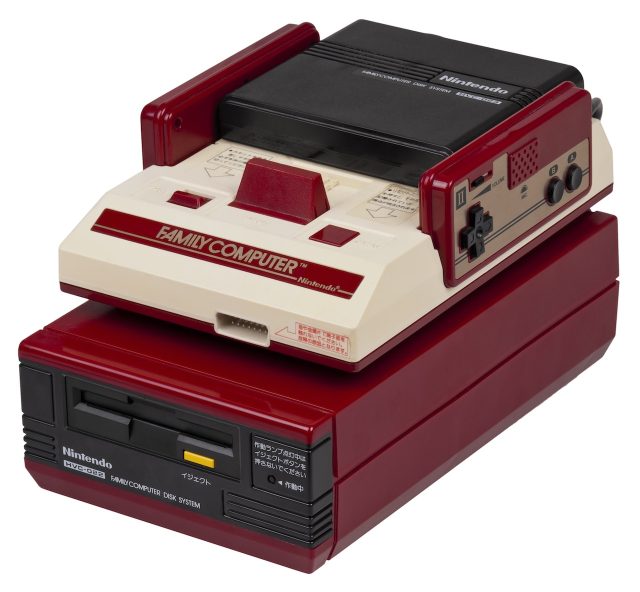 Early on, the Famicom Disk System was a relatively popular way to create larger games with better sound, but cartridges eventually surpassed its capabilities. It never made it to North America.
Early on, the Famicom Disk System was a relatively popular way to create larger games with better sound, but cartridges eventually surpassed its capabilities. It never made it to North America.
The FDS was essentially a floppy disk drive that sat underneath the Famicom. Its double-sided proprietary disks can store about 112KB of data—larger games can use both sides of the disk or even multiple disks, and the disks can be rewritten with new games at in-store kiosks. The included RAM adapter, which plugged into the Famicom's cartridge slot, also extended the console's capabilities. It included two extra sound channels, 32KB of RAM to used to store data copied from the disk (to reduce the amount of time that the disk was active), and 8KB of RAM for storing tiles and sprites.
Its flagship launch title was none other than The Legend of Zelda, which would need the MMC1 chip and a battery to enable its game saving feature when it was released in the US as a cartridge the next year. Generally, the two extra sound channels afforded by the FDS were reserved for sound effects, to prevent those effects from making part of the music track cut out as they do on many standard NES games. In some cases, though, the FDS channels were used to add extra texture and complexity to the music. Compare the FDS version of the Zelda title theme to the NES version to hear how much of a difference they can make.
The Zelda intro theme on the NES.
The Zelda intro theme on the FDS.
Like just about every console add-on accessory that has ever existed (the Sega CD and 32X, the Nintendo 64DD, Sony's EyeToy camera, etc. etc.), the Famicom Disk System wasn't a runaway success. Improvements in cartridge technology, including the aforementioned MMCs, rendered its technical improvements less necessary, while the amount that could be stored on a cartridge eventually outstripped the 112KB that can be stored on the disks. Late-period games like Dragon Warrior 4 can be up to 512KB in size. (Japan's Metal Slader Glory actually topped out at a full megabyte of data!) The disks lacked the protective coverings common on 3.5-inch floppy disks, which made it easy to damage the magnetic storage medium. Finally, onerous licensing terms (Nintendo wanted a partial copyright for any game published on the FDS) rendered many third parties uninterested in supporting the add-on, subject as they already were to Nintendo's stringent licensing requirements.
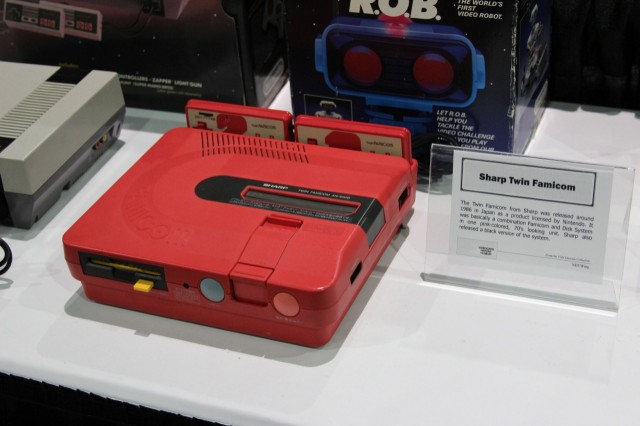
The Sharp Twin Famicom was a licensed Famicom clone that combined the Famicom and the FDS into a single package.
Several high-profile titles like Zelda, Metroid, Castlevania, and Super Mario Bros. 2 (the Japanese version, called The Lost Levels when it finally came to the US as part of the SNES' Super Mario All-Stars cartridge) all made their debuts on the FDS. Big-name games eventually moved back to cartridges, though, and FDS sales petered out at around 4.5 million units.
Life after death: keeping the games, the hardware, and the style alive
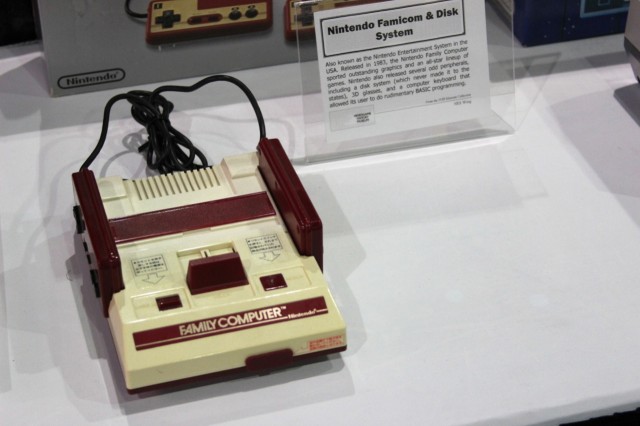
Nintendo made new Famicoms in Japan until 2003, and fixed old ones until 2007.
Nintendo of America produced new NES consoles until 1995, while the Famicom, the Super Famicom, and the FDS were produced in Japan until 2003; the company stopped offering repair consoles for any of the consoles in 2007. That's a pretty remarkable multi-decade run no matter how you slice it. But that was hardly the end of the line for the 8-bit powerhouse, though—both the fans and Nintendo itself have kept the Famicom's game library alive well into the present day.
It started with independently developed emulators. In the late '90s and early 2000s, as physical NES hardware and software became more difficult to find, some enthusiasts turned to the increasingly affordable, increasingly powerful computers on their desks to play old software. A crudely named program called NESticle was one of the earliest free NES emulators to achieve playability for a wide variety of games. It helped to launch an emulation scene that has produced playable emulators for dozens of consoles since.
In the early days, emulators like NESticle and Zsnes mostly concentrated on making as many retail games as playable as possible. Both then and now, while the emulators themselves are legal as long as they don't include proprietary code (like the BIOS files needed to boot the original PlayStation, for example), obtaining games to play on them has always been a legal grey area at best. Downloading these games (usually called ROMs after the read-only memory chips they were first ripped from) without owning a physical copy of the game is definitely illegal. Even if you own a "backup copy" of the actual cartridge, a ROM may be illegal unless you ripped it yourself.
In more recent years, as computers have gotten even faster and cheaper, some third-party emulators have come to value emulation accuracy as much as, if not more than, playability. Byuu, the developer behind the Super Famicom emulator bsnes, gave us some insight into that world a couple of years ago. To these developers, preserving accurate emulators is an issue of archiving and preserving gaming's heritage just as much as it is about playing A Boy and his Blob on your MacBook.
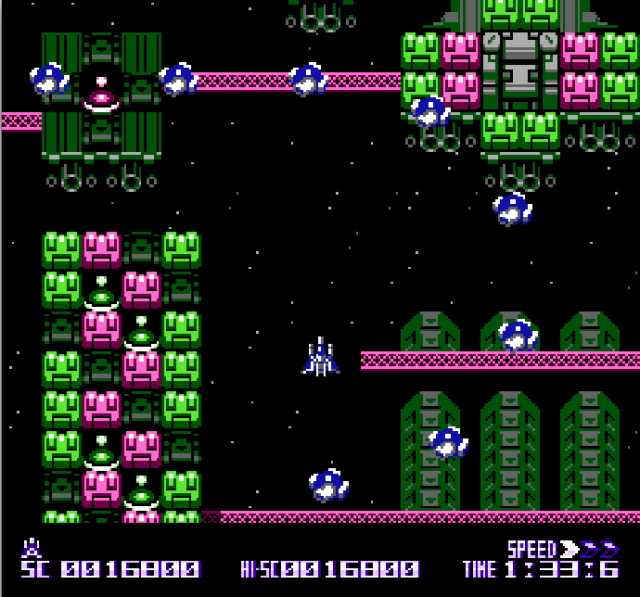 The availability of emulators makes it easier for homebrew developers to create their own games for old consoles, though relatively few high-quality games are released this way. This is a screenshot from Blade Buster, a circa-2010 homebrew title of some small renown.
The availability of emulators makes it easier for homebrew developers to create their own games for old consoles, though relatively few high-quality games are released this way. This is a screenshot from Blade Buster, a circa-2010 homebrew title of some small renown.
"Take a look at Nintendo's Game and Watch hardware," Byuu wrote. "These devices debuted in 1980, and by now most of the 43 million produced have failed due to age or have been destroyed. Although they are still relatively obtainable, their scarcity will only increase, as no additional units will ever be produced. This same problem extends to any hardware: once it's gone, it's gone for good. At that point, emulators are the only way to experience those old games, so they should be capable of doing so accurately."
Especially in the last console generation, emulation went from being a way for hackers and maybe-pirates to get their old-school fix to being a relatively inexpensive way for gaming's older companies to milk their back catalogs. Nintendo in particular has proven only too willing to sell you your childhood over and over again via its Virtual Console emulation service, which it seems to re-launch every time it creates a new system. In North America, a total of 93 NES games are available on the original Wii's virtual console (and the Wii U, playing in Wii Mode); only 27 are available on the 3DS, only 19 are available on the Wii U. Games available on all three must be purchased three separate times if you want to own them on all the devices.
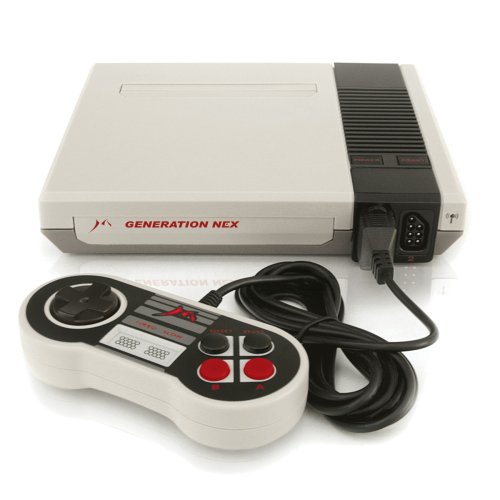
The Generation Nex, a prominent NES clone that can accept both NES and Famicom cartridges.
If you still have old cartridges laying around and don't want to track down an original console to play them on, the expiration of most of Nintendo's NES patents means that building and selling NES-compatible third-party systems is no longer the dubious activity it once was. These consoles, sometimes referred to as "Famiclones," sometimes boast compatibility with both NES and Famicom cartridges, as well as Super Nintendo and Genesis carts in certain cases. However, they use newer chips meant to simulate the original consoles' rather than carbon copies of the originals, which tends to cause compatibility problems. Later and more complicated Famicom titles like Castlevania III tend to give these systems trouble, and gamers looking for an authentic old-school fix would still be better off tracking down an original console.
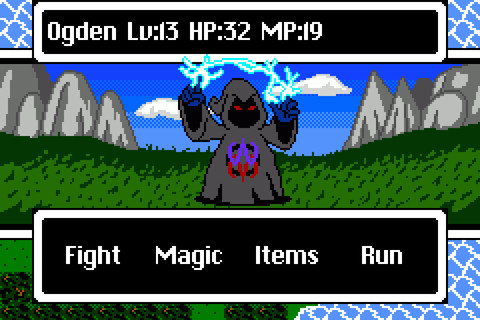
Dragon Fantasy is an iOS game with an NES flair.
Even discounting the people developing actual NES-compatible hardware and software, developers for newer systems pay homage to the NES all the time. Some games, like Capcom's Mega Man 9 and10, are painstaking in their devotion to the original console's aesthetic. Retro City Rampage creator Brian Provinciano went so far as to create a version of his game that actually works under the NES' strict hardware limitations. Indie developers like Adam Rippon and ZeBoyd, on the other hand, merely draw inspiration for games like Dragon Fantasy and Breath of Death VII from the NES and Famicom era.
The kids who played the NES have all grown up, and a whole bunch of them are ignoring the exponentially more powerful hardware capabilities of modern consoles in favor of the systems they cut their teeth on. Maybe in a few years the generation that came of age playing the Nintendo 64 and the original PlayStation will bring blurry textures, rampant jaggies, and disc switching back into vogue. For now, 8-bit and 16-bit nostalgia is decidedly in fashion.
So happy birthday, Famicom! For a 30-year-old, you're still looking pretty good.
No comments:
Post a Comment
Let us know your Thoughts and ideas!
Your comment will be deleted if you
Spam , Adv. Or use of bad language!
Try not to! And thank for visiting and for the comment
Keep visiting and spread and share our post !!
Sharing is a kind way of caring!! Thanks again!